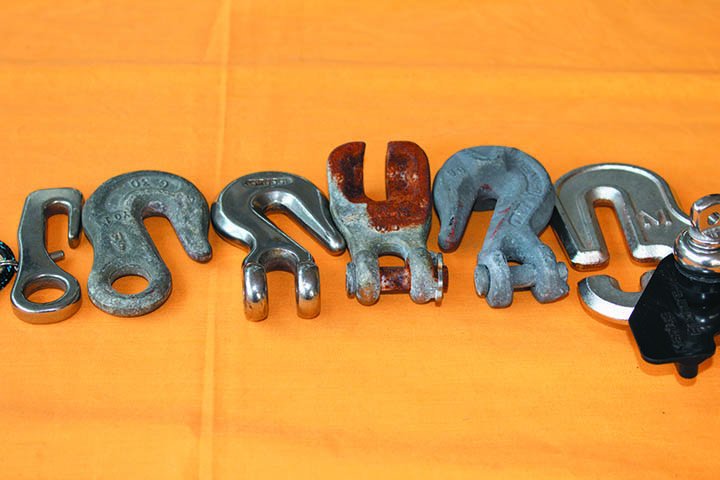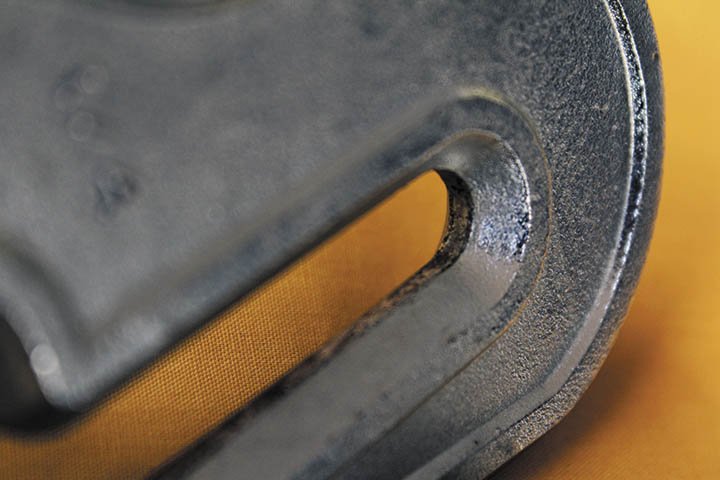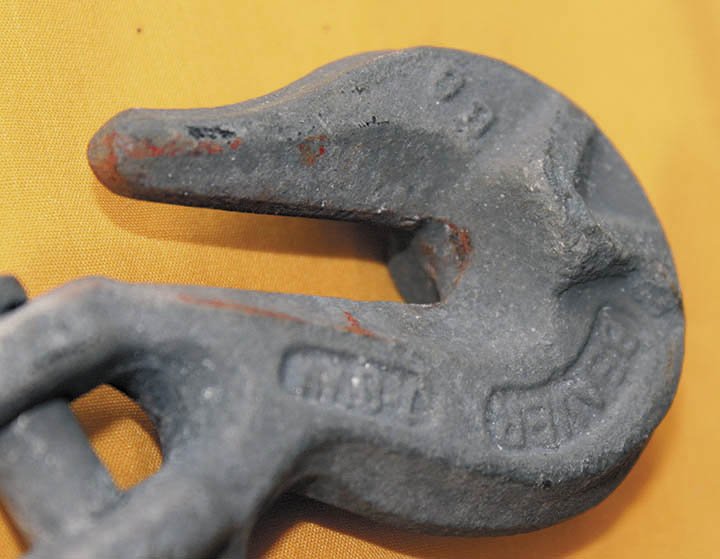
In the March 2016 article Changing views on chain hooks, we pointed out that the major manufacturers of marine anchor chains caution that some chain hooks can weaken chains under extreme loads. These chain hooks are often used to attach an anchor snubber to the anchor chain. We confirmed this effect with testing and advised that if you want to use a hook to attach your anchor snubber you should use a hook that doesn’t weaken the chain through point-loading (i.e. concentrating the loads on a small area of the chain link). Greg Kutsen, president of Mantus, the maker of one of the chain hooks that we tested, contends that the real-life loads encountered when anchoring with a snubber are too small to worry about any point-loading caused by the hook on the chain. Kutsen explains the reasons for his view here.
I would like to respond to the article in the March 2016 issue of Practical Sailor, Changing views on chain hooks, which challenges a commonly accepted practice of using chain hooks to attach snubbers to the chain. The article argues that most common chain hooks are known to point-load the chain and refers to the chain manufacturers caution that chain hooks can weaken the chain ‘reducing the breaking strength of the chain by 20-25 percent.’
The article claims that the Mantus chain hook reduced the breaking strength of the chain by 40 percent. The article suggests that any device promoted to attach a snubber to an anchor chain should not detract from the strength of the chain. Finally, the article concludes that, for this reason, a gripping hitch remains our first choice for attaching a snubber to chain. [Editors note: PS tested gripping hitches in the May 2016 issue.]
As the April 2016 article pointed out, there exist cradling hooks designed for shortening chain that will not weaken chain. However, most stainless-steel hooks on the marine market are of a different design, which do impart some point loading. Made of stainless-steel and designed specifically for marine use, the Mantus hook is no different in that regard. However, the assertion that Mantus hook exacerbates the point loading was derived using an undersized -inch hook with larger 5/16-chain. The other hooks in the test were appropriately sized to match the chain. Using an undersized hook reduces the contact area between the hook and the chain link, so it is to be expected that using the undersized Mantus hook would point load the chain to a greater degree as compared to using a hook that was designed to 5/16 chain. [Editors note: PS is planning to retest the Mantus hook with a properly matched chain and hook. The focus of our testing was to identify hook designs that do not reduce the chain strength to any significant degree, not to quantify the differences between the hooks that do.]


The article states: We think any device promoted for attaching a snubber to an anchor chain should not detract from the strength of the anchor rode or easily become detached. The likelihood of a chain hook leading to chain failure in marine application is unknown, but our tests and the lifting industrys strongly worded cautions regarding this are enough reason to be wary.
I am concerned that some sailors may interpret your report to mean that chain hooks are potentially not safe to use for attaching a snubber line to chain. At first look, it might seem reasonable that a chain hook should match the strength of the chain, and that if the hook can weaken the chain by point loading it, one should look for an alternative mode of snubber attachment. However, let us examine the loads on anchor rode, the effect of the snubber on these loads and how these loads differ from the ones a chain experiences in the absence of the snubber.
The American Boat and Yacht Council publishes standards used by manufacturers as guide to help design marine hardware. The ABYC ground tackle loads table is generally accepted as very conservative and in the words of Tom Hale, past ABYCs technical director assumed worst case situations including sea state and surge, and the figures were subjected to a hefty, but now unknown, safety factor that over the years has made the table a trustworthy guide. PS refers to these loads in the September 2004 article, The Load on Your Rode. [This topic was explored in a May 2012 article, “Anchor Testing and Rode Loads,” as well.]
In an example: a 40-foot boat in a 60-knot sustained windstorm, the worst expected loads as predicted by ABYC would be 4,898 pounds. Again most experts would agree that these numbers account for the dynamic loads that could be induced by waves and wind gusts on top of the static wind loads that assume the worst drag coefficients. Further these loads can be significantly reduced by the use of the snubber/bridle.
The very reason to use a chain hook is to connect a snubber to the chain and dissipate these loads. This is quite different from using a chain hook for attaching two stretches of chains together or for shortening the chain as is done in the lifting industry. Thus the snubber and the snubbing hook will never see the loads the chain would see when used without shock dampening.
Shock loads are usually assumed to be three times the static loads. A recent article on snubbers published in the March 2016 issue of Practical Sailor explores this topic. The loads on a chain rode with a proper snubber are 1/3 the ABYC values: around 1,600 pounds for a 40-foot boat in 60-knots. These estimates agree with previously published data (measured loads on anchor rode) published by: Robert Smith Anchor Loads analysis 1983, Don Dodds 1997 Ocean Navigator, and Practical Sailor, March 2016.
The March 2016 issue, which focused on snubber loads, tabulated the loads for a 40-foot monohull boat in 60-knots with the following scenarios:
Chain with no snubber (not elastic system, shock loads present) – 4,140 pounds
ABYC worst case (assuming not elastic system, shock loads present) – 4,898 pounds
Chain with a 30 foot inch three strand nylon bridle (shock loads mitigated) -1,574 pounds (62 percent reduction in peak loads or about 1/3 of the ABYC worst case)
5/16 Grade 30 chain breaking strength – 7,600 pounds
If we say that -inch, three-strand nylon is the appropriate size for a bridle for a 40-foot boat. The working load limit for this line is 937 pounds and if doubled (since there are two legs to a bridle), the working load limit for a 30-foot, -inch three-strand nylon bridle becomes 1,874 pounds. Realistically, the two legs of the bridle are loaded asymmetrically (one leg carries more load than the other), so 1,874 pounds is an overestimate for the bridle working load limit.
For reference, the Mantus hook designed for 5/16 chain has the working load limit of 1,877 and an ultimate breaking strength of 7,511 pounds.
To summarize these loads on the rode for a 40-foot boat in sustained 60 knots of wind:
Maximum load predicted on the chain with a 30-foot bridle: 1,574 pounds
Bridle working load limit (30-feet -inch three-strand nylon bridle): 1,874 pounds
(overestimate, see above. Also assuming brand new line)
Working load limit for a 5/16 Mantus chain hook: 1,877 pounds (ultimate breaking strength 7,511 pounds)
Working load limit for 5/16 Grade 30 chain: 1,900 pounds (ultimate breaking strength 7,600 pounds)
Size 5/16 Grade 30 chain has the ultimate breaking strength of 7,600 pounds, so the argument that a chain hook attached to a properly-sized nylon snubber might weaken the chain and cause a catastrophe is flawed. This is why hooks have been used for decades without an issue. If there is a single anecdote of chain failing due to the use of the chain hook as an attachment for a bridle I would really want to hear about it.
Ropes, however, can indeed fail due to age related ultra-violet degradation and chafe, and if the snubber fails loads on anchor chain may actually get to the ABYC predicted 4,898 pounds and certainly chain, the anchor, swivel and the deck hardware should be adequately sized to handle these loads.






































